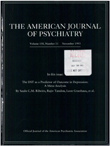Treatment of seasonal affective disorder with green light and red light
Abstract
OBJECTIVE: This study sought to determine whether an equal photon density of green light is superior to red light in treating seasonal affective disorder. METHOD: After recruitment through the media, 20 outpatients with seasonal affective disorder participated in a balanced- order crossover trial of 1 week of green light therapy compared with 1 week of red light therapy. Each treatment consisted of 2 hours of daily light treatment at home in the early morning. Ultraviolet light was excluded from both treatment conditions. The photon densities of the two treatments (2.3 x 10(15) photons/sec per cm2) were similar to those used in previous studies of therapy with 2500-lux white light. Fourteen patients completed the study. At least 1 week separated each treatment period to allow time for relapse. Effectiveness of treatment was assessed by analysis of variance of changes in ratings on the Hamilton Rating Scale for Depression. RESULTS: Although patients' expectations of the two treatments were similar, green light induced greater antidepressant effects than red light. A Sequence by Color interaction was also demonstrated. CONCLUSIONS: Green light provides a treatment effect superior to that of red light and similar to that seen in previous studies with white light. These results are consistent with the hypothesis that retinal photoreceptors mediate the antidepressant response in seasonal affective disorder. Identifying optimal wavelengths for light treatment is important in optimizing phototherapy efficacy.
Access content
To read the fulltext, please use one of the options below to sign in or purchase access.- Personal login
- Institutional Login
- Sign in via OpenAthens
- Register for access
-
Please login/register if you wish to pair your device and check access availability.
Not a subscriber?
PsychiatryOnline subscription options offer access to the DSM-5 library, books, journals, CME, and patient resources. This all-in-one virtual library provides psychiatrists and mental health professionals with key resources for diagnosis, treatment, research, and professional development.
Need more help? PsychiatryOnline Customer Service may be reached by emailing [email protected] or by calling 800-368-5777 (in the U.S.) or 703-907-7322 (outside the U.S.).



